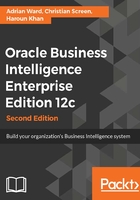
Why is there a database repository for OBIEE?
Similar to the previous Oracle BI version, Oracle BI 12c requires a relational database repository schema to hold metadata concerning the installation, report scheduling, usage tracking, auditing, and other aspects of the environment. As an initial set of steps in the installation process, these very necessary repositories are created using the Repository Creation Utility (RCU) against the selected database server. Chapter 2, Installing the Pre-requisite Software, goes into greater detail about this crucial repository structure. In Oracle BI 11g, two database schemas were installed with the RCU-Metadata Services (MDS) and BIPLATFORM. However, in Oracle BI 12c there can be up to nine database repository schemas for Oracle BI 12c that can be installed via the Oracle BI 12c RCU. There are now even more repository schemas that must be installed for Oracle BI 12c to be correctly installed and configured. The additional required schemas will have the suffixes WLS, WLS_RUNTIME, STB, and OPSS. Other schemas available are for auditing purposes, if optionally chosen for the implementation.
Note
Another interesting fact is that the Oracle BI Metadata Repository (RPD) is still a file, typically prefixed as RPD (that is, .rpd extension) and even in the latest version of Oracle BI the metadata is not stored in any database repository.
The Oracle BI Metadata Repository is the metadata storage mechanism in which Oracle BI developers model and map physical data sources to logical business representations in order for the resulting analytics to be easily consumed by end users.
The term Oracle BI Domain, as noted previously and shown in the illustration, is used as a way to group all Oracle BI 12c components within the Fusion Middleware (that is, WebLogic Server) architecture. This should not be confused with the WebLogic Application Server Domain, which is given the default name bi when following the default Oracle BI 12c installation options. The latter is a WebLogic Java Application Server term. The former is a Fusion Middleware term. Since Fusion Middleware is so closely related to the WebLogic Application Server, this is good to keep in mind from a technical perspective.
Note
When learning about the overall component composition, a very important detail to keep in mind is the manner in which the components are managed. Since WebLogic Server is a Java application server, it manages all of the Oracle BI components developed in the Java programming language. The Oracle BI System Components are now managed by the WebLogic Management Framework (WMF) which is the same system that manages the WebLogic Scripting Tool (WLST) functionality.